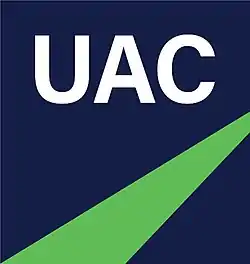Universities Admissions Centre
The Universities Admissions Centre (UAC, pronounced /ˈjuːæk/ YOO-ak) is an organisation that processes applications for admission to tertiary education courses, mainly at institutions in New South Wales and the Australian Capital Territory. A not-for-profit company incorporated in July 1995, it has offices located at Sydney Olympic Park.[1]
Universities Admissions Centre (NSW and ACT) Pty Ltd (UAC) | |
 | |
| Location |
|
|---|---|
Key people | Dr David Christie, Managing director Professor Denise Kirkpatrick, Chairperson |
| Website | www |
Role
UAC calculates the Australian Tertiary Admission Rank (ATAR) of NSW Higher School Certificate (HSC) students, and processes applications to its participating institutions based on the selection rank of prospective students.[2] A student's selection rank for each subject is composed of their ATAR, plus any adjustment points individual institutions may offer for reaching certain targets in specific subjects.[3]
Students rank tertiary courses in order of preference, and if a student reaches the required selection rank for any of the courses in their list, the student receives an offer of admission for the course ranked highest in the list. This process occurs over multiple rounds, such that if a student misses an offer in one round, they may receive an offer in subsequent rounds.[2]
In addition, UAC:[2]
- processes applications for Educational Access Schemes (EAS), and for some Equity Scholarships and Schools Recommendation Schemes.
- produces a range of print and online publications including admission requirements and course information for potential applicants.
UAC is a member of the Australasian Conference of Tertiary Admission Centres (ACTAC).
Scaling
In order to calculate the ATAR for HSC students, UAC adjusts students' HSC marks in a process known as scaling. Given the lack of comparability between subjects of different difficulties, the spread of students' marks in each individual subject is adjusted so the mean, the standard deviation and the maximum mark in each course are equivalent. UAC then shifts the mean mark and spread of marks in each subject to equal the mean mark and spread of marks that the students of that one subject attained in all other subjects. Finally, UAC aggregates scores into a single mark out of 500 for each student, and then gives students a percentile ranking in increments of 0.05 based on this aggregate. This percentile ranking is the ATAR.[4][5]
In practice, this means that if two students receive the same HSC marks for each subject, but one student takes more higher-scaling subjects, and the other takes more lower-scaling subjects, the student who took higher-scaling subjects would attain a better ATAR.[4] In a 2018 survey, 35.8% of HSC students said they chose one or more subjects because they believed it would help them achieve a higher ATAR.[6]
Participating institutions
UAC acts on behalf of 18 universities in Australia, primarily located in New South Wales and the ACT:[7]
- Australian Catholic University
- Australian National University
- Charles Darwin University
- Charles Sturt University
- Central Queensland University
- Griffith University
- La Trobe University
- Macquarie University
- Southern Cross University
- Torrens University Australia
- University of Canberra
- University of New England
- University of Newcastle
- University of Sydney
- University of Technology Sydney
- University of Wollongong
- University of New South Wales
- Western Sydney University
UAC also administers applications on behalf of eight other accredited tertiary education providers:[7]
References
- "Annual Report 2017-18" (PDF). Universities Admissions Centre. January 2019. Retrieved 2020-02-08.
- "Response to the Higher Education Standards Panel's Consultation on the Transparency of Higher Education Admissions Processes" (PDF). Department of Education, Skills and Employment. May 2016. Retrieved 2020-02-08.
- "University Selection Rank Adjustments". Universities Admissions Centre. Retrieved 2020-02-09.
- "Report on the Scaling of the 2018 NSW Higher School Certificate" (PDF). Universities Admissions Centre. May 2019. Retrieved 2020-02-08.
- "Can you game the ATAR?". The Sydney Morning Herald. Retrieved 2020-02-09.
- "Gaming the ATAR - huge numbers of school kids are trying to do it". Australian Financial Review. 2018-05-29. Retrieved 2020-02-09.
- "UAC's participating institutions". Universities Admissions Centre. Retrieved 2020-11-24.